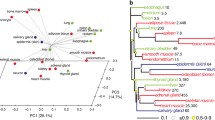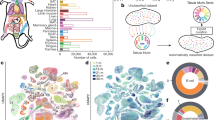Abstract
Discovering key cellular and molecular traits that promote longevity is a major goal of aging and longevity research. One experimental strategy is to determine which traits have been selected during the evolution of longevity in naturally long-lived animal species. This comparative approach has been applied to lifespan research for nearly four decades, yielding hundreds of datasets describing aspects of cell and molecular biology hypothesized to relate to animal longevity. Here, we introduce a Comparative Cellular and Molecular Biology of Longevity Database, available at (http://genomics.brocku.ca/ccmbl/), as a compendium of comparative cell and molecular data presented in the context of longevity. This open access database will facilitate the meta-analysis of amalgamated datasets using standardized maximum lifespan (MLSP) data (from AnAge). The first edition contains over 800 data records describing experimental measurements of cellular stress resistance, reactive oxygen species metabolism, membrane composition, protein homeostasis, and genome homeostasis as they relate to vertebrate species MLSP. The purpose of this review is to introduce the database and briefly demonstrate its use in the meta-analysis of combined datasets.




Similar content being viewed by others
References
Barja G, Cadenas S, Rojas C, López-Torres M, Pérez-Campo R (1994) A decrease of free radical production near critical targets as a cause of maximum longevity in animals. Comp Biochem Physiol Biochem Mol Biol 108(4):501–512
Bergmann O, Bhardwaj RD, Bernard S, Zdunek S, Barnabe-Heider F, Walsh S, Zupicich J, Alkass K, Buchholz BA, Druid H, Jovinge S, Frisen J (2009) Evidence for cardiomyocyte renewal in humans. Science 324:98–102
Bhardwaj RD, Curtis MA, Spalding KL, Buchholz BA, Fink D, Bjork-Eriksson T, Nordborg C, Gage FH, Druid H, Eriksson PS, Frisen J (2006) Neocortical neurogenesis in humans is restricted to development. Proc Natl Acad Sci U S A 103:12564–12568
Brown MF, Stuart JA (2007) Correlation of mitochondrial superoxide dismutase and DNA polymerase beta in mammalian dermal fibroblasts with species maximal lifespan. Mech Ageing Dev 128:696–705
Caulin AF, Maley CC (2011) Peto’s Paradox: evolution’s prescription for cancer prevention. Trends Ecol Evol 26:175–182
Cortopassi GA, Wang E (1996) There is substantial agreement among interspecies estimates of DNA repair activity. Mech Ageing Dev 91:211–218
de Magalhães JP, Costa J (2009) A database of vertebrate longevity records and their relation to other life-history traits. J Evol Biol 22:D537–D543
Felsenstein J (1985) Phylogenies and the comparative method. Am Nat 125:1–15
Foksinski M, Rozalski R, Guz J, Ruszkowska B, Sztukowska P, Piwowarski M, Klungland A, Olinski R (2004) Urinary excretion of DNA repair products correlates with metabolic rates as well as with maximum life spans of different mammalian species. Free Radic Biol Med 37:1449–1454
Francis AA, Lee WH, Regan JD (1981) The relationship of DNA excision repair of ultraviolet-induced lesions to the maximum life span of mammals. Mech Ageing Dev 16:181–189
Gensler HL, Bernstein H (1981) DNA damage as the primary cause of aging. Quart Rev Biol 56:270–303
Gomes NMV, Ryder OA, Houck ML, Charter SJ, Walker W, Forsyth NR, Austad SN, Venditti C, Pagel M, Shay JW, Wright WE (2011) Comparative biology of mammalian telomeres: hypotheses on ancestral states and the roles of telomeres in longevity determination. Aging Cell 10(5):761-8
Grube K, Burkle A (1992) Poly(ADP-ribose) polymerase activity in mononuclear leukocytes of 13 mammalian species correlates with species-specific life span. Proc Natl Acad Sci U S A 89:11759–11763
Hall KY, Hart RW, Benirschke AK, Walford RL (1984) Correlation between ultraviolet-induced DNA repair in primate lymphocytes and fibroblasts and species maximum achievable life span. Mech Ageing Dev 24:163–173
Harman D (1956) Aging: a theory based on free radical and radiation chemistry. J Gerontol 11:298–300
Harman D (1972) The biologic clock: the mitochondria? J Am Geriatr Soc 20:145–147
Harper JM, Salmon AB, Leiser SF, Galecki AT, Miller RA (2007) Skin-derived fibroblasts from long-lived species are resistant to some, but not all, lethal stresses and to the mitochondrial inhibitor rotenone. Aging Cell 6:1–13
Harper JM, Wang M, Galecki AT, Ro J, Williams JB, Miller RA (2011) Fibroblasts from long-lived bird species are resistant to multiple forms of stress. J Exp Biol 214:1902–1910
Hart RW, Setlow RB (1974) Correlation between deoxyribonucleic acid excision-repair and life-span in a number of mammalian species. Proc Natl Acad Sci U S A 71:2169–2173
Haussmann MF, Winkler DW, O’Reilly KM, Huntington CE, Nisbet ICT, Vleck CM (2003) Telomeres shorten more slowly in long-lived birds and mammals than in short-lived ones. Proc R Soc Lond B 270:1387–1392
Hulbert AJ (2005) On the importance of fatty acid composition of membranes for aging. J Theor Biol 234:277–288
Hulbert AJ (2008) Explaining longevity of different animals: is membrane fatty acid composition the missing link? Age 30:89–97
Kapahi P, Boulton ME, Kirkwood TB (1999) Positive correlation between mammalian life span and cellular resistance to stress. Free Radic Biol Med 26:495–500
Kato H, Harada M, Tsuchiya K, Moriwaki K (1980) Absence of correlation between DNA repair in ultraviolet irradiated mammalian cells and lifespan of the donor species. Jpn J Genet 55:99–108
Leroi AM, Koufopanou V, Burt A (2003) Cancer selection. Nat Rev Canc 3:226–231
Licastro F, Walford RL (1985) Proliferative potential and DNA repair in lymphocytes from short-lived and long-lived strains of mice, relation to aging. Mech Ageing Dev 31:171–186
Lopez-Torres M, Perez-Campo R, Rojas C, Cadenas S, Barja G (1993) Maximum life span in vertebrates: relationship with liver antioxidant enzymes, glutathione system, ascorbate, urate, sensitivity to peroxidation, true malondialdehyde, in vivo H2O2, and basal and maximum aerobic capacity. Mech Ageing Dev 70(3):177–199
Lorenzini A, Johnson FB, Oliver A, Tresini M, Smith JS, Hdeib M, Sell C, Cristofalo VJ, Stamato TD (2009) Significant correlation of species longevity with DNA double strand break recognition but not with telomere length. Mech Ageing Dev 130:784–792
Ogburn CE, Carlberg K, Ottinger MA, Holmes DJ, Martin GM, Austad SN (2001) Exceptional cellular resistance to oxidative damage in long-lived birds requires active gene expression. J Gerontol A Biol Sci Med Sci 56:B468–B474
Ono T, Okada S (1984) Unique increase of superoxide dismutase level in brains of long living mammals. Exp Gerontol 19:349–354
Page MM, Stuart JA (2011) Activities of DNA base excision repair enzymes in liver and brain correlate with body mass, but not lifespan. Age (in press)
Page MM, Richardson J, Wiens BE, Tiedtke E, Peters CW, Faure PA, Burness G, Stuart JA (2010) Antioxidant enzyme activities are not broadly correlated with longevity in 14 vertebrate endotherm species. Age 32:255–270
Pamplona R, Barja G, Portero-Otin M (2002) Membrane fatty acid unsaturation, protection against oxidative stress, and maximum lifespan—a homeoviscous-longevity adaptation? Ann NY Acad Sci 959:475–490
Pérez VI, Bokov A, Van Remmen H, Mele J, Ran Q, Ikeno Y, Richardson A (2009) Is the oxidative stress theory of aging dead? Biochim Biophys Acta 1790:1005–1014
Porter RK, Brand MD (1995) Cellular oxygen consumption depends on body mass. Am J Physiol 269:R226–R228
Promislow DE (1994) DNA repair and the evolution of longevity: a critical analysis. J Theor Biol 170(3):291–300
Salway KD, Gallagher EJ, Page MM, Stuart JA (2011a) Higher levels of heat shock proteins in longer-lived mammals and birds. Mech Ageing Dev 132(6–7):287–297
Salway KD, Page MM, Faure PA, Burness G, Stuart JA (2011b) Enhanced protein repair and recycling are not correlated with longevity in 15 vertebrate endotherm species. Age (Dordr) 33(1):33–47
Seluanov A, Chen Z, Hine C, Sasahara TH, Ribeiro AA, Catania KC, Presgraves DC, Gorbunova V (2007) Telomerase activity coevolves with body mass not lifespan. Aging Cell 6:45–52
Speakman JR (2005) Correlations between physiology and lifespan—two widely ignored problems with comparative studies. Aging Cell 4:167–175
Stuart JA, Page MM (2010) Plasma IGF-1 is negatively correlated with body mass in a comparison of 36 mammalian species. Mech Ageing Dev 131:591–598
Tolmasoff JM, Ono T, Cutler RG (1980) Superoxide dismutase: correlation with life-span and specific metabolic rate in primate species. Proc Natl Acad Sci U S A 77:2777–2781
Valencak TG, Ruf T (2007) N-3 polyunsaturated fatty acids impair lifespan but have no role for metabolism. Aging Cell 6:15–25
Author information
Authors and Affiliations
Corresponding author
About this article
Cite this article
Stuart, J.A., Liang, P., Luo, X. et al. A comparative cellular and molecular biology of longevity database. AGE 35, 1937–1947 (2013). https://doi.org/10.1007/s11357-012-9458-y
Received:
Accepted:
Published:
Issue Date:
DOI: https://doi.org/10.1007/s11357-012-9458-y




